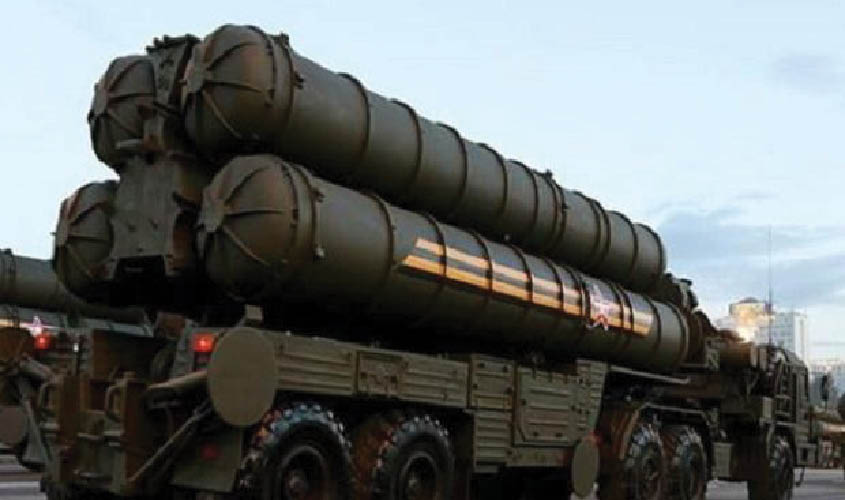New Delhi: International security experts believe that the usefulness of Russia’s S-400 Triumf missile system is still open to judgement, especially in the context of the threat to India from China and Pakistan. India has signed an agreement with Russia to buy the S-400 and a debate is going on in the country over the pros and cons of the system, apart from the long-term benefits or, more importantly, losses of buying the missile system from Russia. Buying the S-400 from Russia is likely to lead to a possible array of sanctions from the United States. It is also likely to alter India’s long term geopolitical future and security implications. Experts believe that the usefulness of S-400, especially in India’s context, might be “over-hyped”.
Justin Bronk, who is a Research Fellow with the London-based Royal United Services Institute (RUSI)—the world’s oldest independent think tank on international defence and security—and specialises in combat air-power and technology, said that S-400s could be “spoofed”, adding that India should keep in mind that the same system was also being used by China.
Bronk told The Sunday Guardian: “With a view to China as a potential military threat for India, they have also purchased the S-400. This means that the People’s Liberation Army Air Force (PLAAF) will understand the S-400 very well and can train against it in depth, meaning that it may not be a long-term credible deterrent for India against the PLAAF.”
“There are two separate features of the S-400 in an Indian context. The first is that the system includes a variety of radars which offer the opportunity to enhance India’s airspace awareness capabilities if properly integrated. These radars, coupled with the command module of the S-400, might also give options for linking and enhancing the capabilities of other SAM (Surface-to-Air Missile) systems already in use. The second feature is the system’s defensive abilities using the range of missiles which form part of the S-400 complex. These are genuinely formidable again fixed wing, rotary and cruise missile targets, as well as proving some ballistic missile defence options,” he added.
However, he said that the system’s capabilities were over-hyped. “It has been over-hyped in the sense that just like any SAM system, the S-400 can still
China became the first foreign buyer of Russia’s S-400 when it placed an order of four to six Russian-made S-400 regimental units in 2014 for an estimated $3 billion. The last of these systems were delivered in July 2018.
Petr Topychkanov, who is a Senior Researcher, Disarmament, Arms Control and Non-Proliferation Programme with the Stockholm International Peace Research Institute, said that S-400 was unlikely to intercept all types of missiles that Pakistan might fire at India in the future.
“In principle, it’s hard to assess the usefulness of the S-400 air defence system that India will import, because the technical details of its modification are classified. I mean, the S-400 may have various export versions. This information usually isn’t publicly available,” he said.
“Notably, it’s unclear what will be the range of the interceptors. What is supposedly correct, that if deployed near the border with Pakistan, the S-400 radars will allow observing the airspace over the whole territory of Pakistan. However, the S-400 systems will not be able to intercept all type of missiles, possibly incoming across the entire line of border between India and Pakistan, plus the Line of Control (LoC). The S-400 is designed to defend the locations where it is deployed. In general, the S-400 deal between Russia and India raises questions about Indian plans about how and when to use the imported air-defence systems,” said Topychkanov, who has also served as a fellow from 2006 to 2017 at the Carnegie Moscow Center’s Nonproliferation Program.
The $5.4 billion (Rs 39,000 crore) agreement between India and Russia to buy five S-400 Long Range SAM systems was inked on 5 October 2018 with Minister of Defence (State), Dr Subhash Bhamre, announcing in Parliament that deliveries would commence from October 2020 and would be completed by April 2023.
India is banking on the possibility that it will be saved from the provisions of the United States’ “Countering America’s Adversaries Through Sanctions Act (CAATSA)”—which calls for imposition of certain sanctions on persons/entities that have knowingly engaged in a “significant transaction” with the defence or intelligence sectors of Russia—through a Presidential waiver which will help India to escape the provisions of CAATSA. Under Section 231 of CAATSA, the US Department of State has the authority to determine whether a transaction is “significant” for purposes of Section 231 of CAATSA on a case-by-case basis. Significant transactions are defined as deals above $15 million.
However, the tough stand taken by the Donald Trump administration against Turkey, a NATO member country, to block the sale of the advanced F-35 jets and remove Turkey altogether from the fighter jet programme after that country accepted the delivery of some of the components of S-400 system last week, has given enough signals as to the likely stand the US is going to take when it comes to the delivery of S-400 to India.
Donald Trump did not even wait for the system to be fully delivered to Turkey or it to be deployed before imposing sanctions while stating that Turkey did not accept the US’ counter-offers to take the Patriot system.
The Trump administration has offered Terminal High Altitude Area Defense (THAAD) and Patriot Advance Capability (PAC-3), its two key missile defence systems to India as an alternative to Russian S-400.

